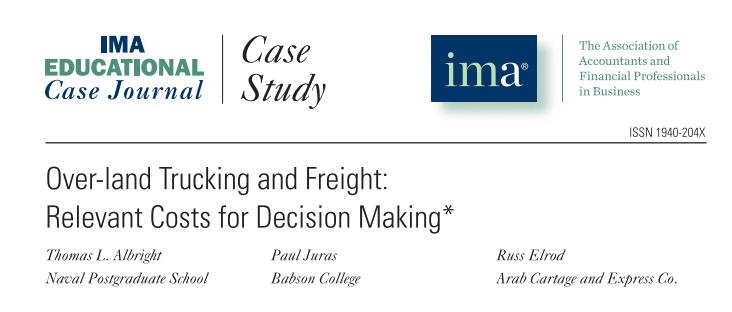Answered step by step
Verified Expert Solution
Question
1 Approved Answer
Read the complete case study: Overlands management is considering the proposal from FHP. There are variety of issues involving strategy, cost, risk and capacity. Use
Read the complete case study: Overland’s management is considering the proposal from FHP. There are variety of issues involving strategy, cost, risk and capacity. Use the following questions to guide your analysis. Considering the FHP proposal, prepare a recommendation to management. Use the questions 3 and 4 in the Decision section at the end of the case study to organize your recommendation. Responses to each question should be substantive with supporting information and calculations.


IMA EDUCATIONAL Case Case Journal Study Over-land Trucking and Freight: Relevant Costs for Decision Making* Thomas L. Albright Naval Postgraduate School ima Paul Juras Babson College The Association of Accountants and Financial Professionals in Business ISSN 1940-204X Russ Elrod Arab Cartage and Express Co. ABSTRACT Over-land Trucking and Freight has a long-established and mutually beneficial business relationship with a major international automotive parts company, FHP Technologies. Management at FHP has approached Over-land with a request to provide additional routes that are important to the efficiency of its supply chain. Over-land s management wishes to nurture the business relationship with FHP but is concerned about the available capacity to service the new routes, potential risks, and profitability associated with FHP s request. INTRODUCTION Alan James founded Over-land Trucking and Freight in 1968 and has grown the business into a sizeable operation with 90 trucks and 180 trailers. His largest customer, FHP Technologies, has submitted a proposal to him to add delivery routes that would improve the efficiency of FHP s supply chain. Alan was not certain that Over-land could handle the additional routes since the company currently was operating at (or near) full capacity. replace older equipment (usually in blocks of five trucks). Alan knew the slim profit margins associated with trucking, coupled with a downturn in the economy, could spell disaster if saddled with too much debt. See Exhibits 1 and 2 for the company s most recent statement of income from operations and the balance sheet, respectively. Roger Simmons, Over-land s operations manager for the past 16 years, had been reviewing the FHP proposal and approached Alan. Alan, we need to discuss this offer from FHP. I think it is a great opportunity for our company, and we need to find a way to make it work. Within 10 minutes Alan and Roger were in a closed-door meeting discussing the pros and cons of FHP s offer. Roger began by stating the obvious: Alan, this is a huge opportunity for us to grow the business. Not to mention, as FHP becomes more dependent on our services, we will be in a stronger position to negotiate future rate increases. I know you are opposed to debt, and I understand the risks of carrying more debt, but there is more than one way to grow our fleet. If you would consider using independent contract drivers, we could grow the fleet enough to accept FHP s offer without incurring more debt. Alan cringed at the thought of using independent contract drivers. Although independent contractors owned their own trucks, Alan viewed them as difficult to deal with and not worth the headache. Roger, I hear you, but this new route will not last a week if we cannot give FHP great service. Independent contractors call the shots, not us. They own the rig and will sit at home if they want to. I would rather deal with our own company s rigs and drivers. The rewards just do not justify the risks of damaging our relationship with FHP. FHP offered a total of $2.15 per mile (including fuel service charge and miscellaneous fees) for the new route. But Alan knew that to accept the offer he would have to add more trucks and perhaps incur additional debt. The question was whether the rates offered by FHP were high enough to offset the associated risks of growing the fleet. Although the business had been grown organically through the years by reinvesting profits, it incurred debt from time to time to *The views expressed in this document are those of the author and do not reflect the offical policy or position of the U.S. Department of Defence or the U.S. government.
Step by Step Solution
★★★★★
3.52 Rating (152 Votes )
There are 3 Steps involved in it
Step: 1
Strategic ImplicationsRisks Expand Business Operations or Not Every business faces strategic risks p...
Get Instant Access to Expert-Tailored Solutions
See step-by-step solutions with expert insights and AI powered tools for academic success
Step: 2

Step: 3

Document Format ( 1 attachment)
6184de6f100d5_85291.docx
120 KBs Word File
Ace Your Homework with AI
Get the answers you need in no time with our AI-driven, step-by-step assistance
Get Started


